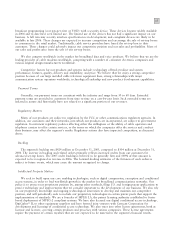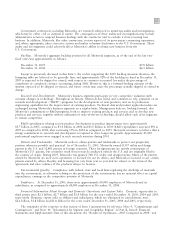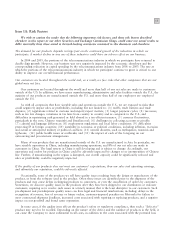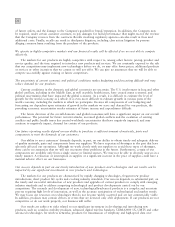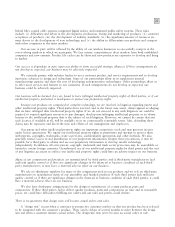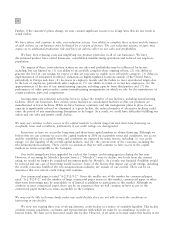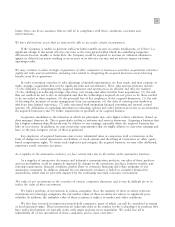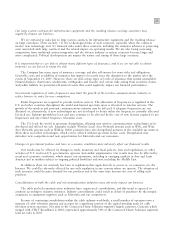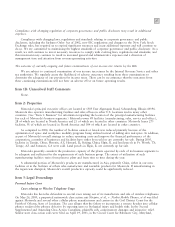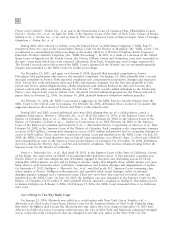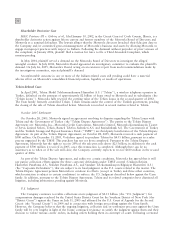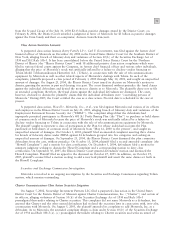Motorola 2005 Annual Report Download - page 31
Download and view the complete annual report
Please find page 31 of the 2005 Motorola annual report below. You can navigate through the pages in the report by either clicking on the pages listed below, or by using the keyword search tool below to find specific information within the annual report.
24
It may be difficult for us to recruit and retain the types of highly-skilled employees that are necessary to remain
competitive.
Competition for key technical personnel in high-technology industries is intense. We believe that our future
success depends in large part on our continued ability to hire, assimilate, retain and leverage the skills of qualified
engineers and other highly-skilled personnel needed to compete and develop successful new products. We may not
be as successful as our competitors at recruiting, assimilating, retaining and utilizing these highly-skilled personnel.
The unfavorable outcome of litigation pending against or future litigation could materially impact the Company.
Our financial results could be materially adversely impacted by unfavorable outcomes to any pending or future
litigation. See ""Item 3 Ì Legal Proceedings.'' There can be no assurances as to the favorable outcome of any
litigation.
We are subject to a wide range of environmental, health and safety laws.
Our operations and the products we manufacture and/or sell are subject to a wide range of global
environmental, health and safety laws. Compliance with existing or future environmental, health and safety laws
could subject us to future costs, liabilities, impact our production capabilities, constrict our ability to sell, expand
or acquire facilities and generally impact our financial performance.
Some of these laws relate to the use, disposal, clean up of, and exposure to hazardous substances. In the
United States, laws often require parties to fund remedial studies or action regardless of fault. Motorola continues
to incur disposal cost and has ongoing remediation obligations. Changes to U.S. environmental laws or our
discovery of additional obligations under these laws could have a negative impact on Motorola.
Over the last several years, the European Union (the ""EU'') countries have enacted environmental laws
regulating electronic products. Our products are impacted by laws that mandate the recycling of waste in electronic
products sold in the EU and that will limit or prohibit the use of certain substances in electronic products
beginning July 1, 2006. Other countries outside of Europe are expected to adopt similar laws. We have incurred
and expect to continue to incur additional expenses to comply with these laws.
We may provide financing and financial guarantees to our customers, some of which may be for significant
amounts.
The competitive environment in which we operate may require us to provide long-term customer financing to a
customer in order to win a contract. Customer financing arrangements may include all or a portion of the purchase
price for our products and services, as well as working capital. In some circumstances, these loans can be very large.
We may also assist customers in obtaining financing from banks and other sources and may also provide financial
guarantees on behalf of our customers. Our success, particularly in our infrastructure businesses, may be dependent,
in part, upon our ability to provide customer financing on competitive terms and on our customers'
creditworthiness.
We also provide revolving, short-term financing to certain customers and distributors that purchase our
equipment. Our success may be dependent, in part, on our ability to provide this financing. Our financial results
could be negatively impacted if our customers or distributors fail to repay this revolving, short-term debt and/or
our sales to such customers or distributors could be reduced in the event of real or perceived issues about the
credit quality of the customer or distributor.
When we lend our customers money in connection with the sale of our equipment, we are at risk of not being repaid.
While we have generally been able to place a portion of our customer financings with third-party lenders, a
portion of these financings are supported directly by us. There can be higher risks of default associated with some
of these financings, particularly when provided to start-up operations such as local network providers, customers in
developing countries, or customers in specific financing-intensive areas of the industry (such as 3G wireless
operators). Should customers fail to meet their obligations on new or existing loans, losses could be incurred and
such losses could negatively impact our financial results.



